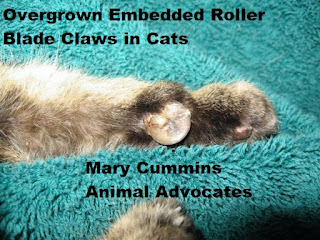OPPOSITION TO VIRGINIA BILL 1354 UNLESS AMENDED
to DelMMartinez, delishin, delhseibold, senatorroem, senatorstanley, senatorboysko, senatorperry, senatorsubramanyam, senatormarsden, senatorfavola, senatorfrench, senatorhackworth, senatorhashmi, senatormulchi, senatorobenshain, senatorpekarsky, senatorsalim, senatorstuart, senatorsuetterlein, senatorwilliamsgraves, info@pawproject, Info@animaladvocates
Animal Advocates has been involved with anti cat declaw for over 20 years. We've worked with The Paw Project during that time to educate the public about how harmful declawing a cat is for humans, animal shelters, veterinarians and cats. The current version is misguided and not based on facts or science, see below. Please, oppose or amend bill HB 1354.
"The current version of the bill, as a result of amendments from the Virginia Veterinary Medical Association, allow any cat to be declawed if the cat’s owner obtains a note from a physician stating that scratches from the cat would pose a health risk for the owner. The bill would reinforce the false idea among human medical doctors that cat scratches are a legitimate human health concern and reason for declawing.
In should be noted that NO human health authority recommends declawing to protect human health. In fact, the Centers for Disease Control and Prevention (CDC), the National Institutes of Health (NIH), the United States Public Health Service (USPHS), and the Infectious Diseases Society of America (IDSA) have gone on record saying that declawing cats is not advised to protect human health. Neither the National Hemophilia Foundation nor the American Cancer Society recommend declawing to protect human patients. The American Association of Feline Practitioners, the Canadian Veterinary Medical Association, and the American Animal Hospital Association agree and cite these human health authority opinions.
This bill would make physicians unwitting collaborators in giving credibility to the premise that declawing can benefit human health. Between uninformed doctors and doctors willing to sign anything to get annoying patients out of their offices quickly, there will still be a loophole. It would also constitute a liability risk to the physicians (and veterinarians) since declawed cats have been proven more likely to bite than non-declawed cats, and bites are a more serious health concern than scratches.
Veterinarians who don't want to declaw will feel pressured by clients who come to their offices with a doctor's note. Veterinarians will find it difficult to say no to a physician’s prescription. Real bans, like the ones in New York and Maryland, help veterinarians who don't want the stress of arguing with a client about declawing. The veterinary profession has a high suicide rate, and this added stress is the kind of thing that contributes to it."
--
Mary Cummins
President
Animal Advocates
www.AnimalAdvocates.us
www.facebook.com/AnimalAdvocatesUSA
- Mary Cummins LinkedIn
- Mary Cummins Meet up
- Animal Advocates custom Facebook name
- Mary Cummins Real Estate blog
- Animal Advocates on Google maps
- Mary Cummins of Animal Advocates
- Mary Cummins biography resume short
- Mary Cummins Real Estate Services
- Animal Advocates fan page at Facebook.com
- Mary Cummins Animal Advocates Squirrel Rescue
- Mary Cummins Animal Advocates on Flickr photos
- Mary Cummins Animal Advocates on Twitter.com
- Mary Cummins on Picasa web photo albums
- Mary Cummins on MySpace.com
- Mary Cummins on Google Blogger Blogspot
- Mary Cummins on YouTube.com videos
- Mary Cummins of Animal Advocates on Classmates
- Mary Cummins on VK
- Mary Cummins of Animal Advocates on Google+































